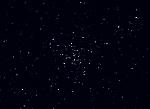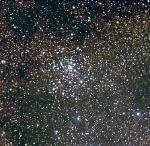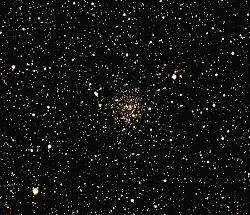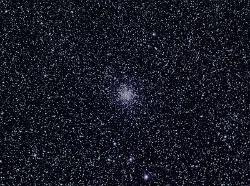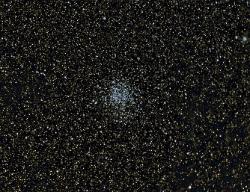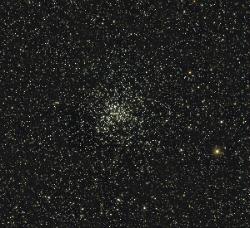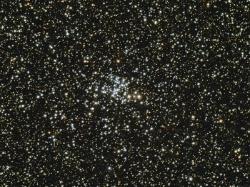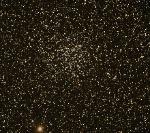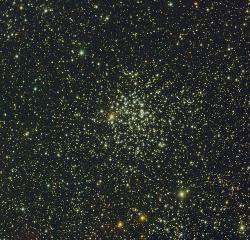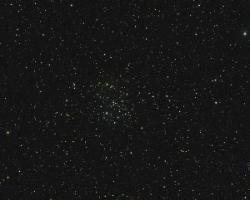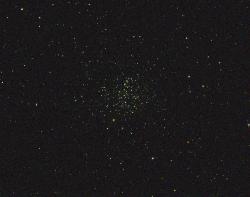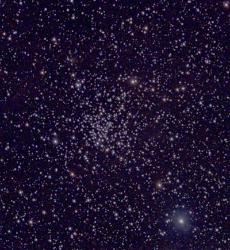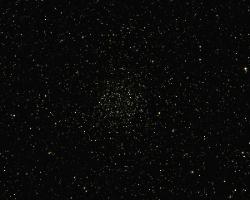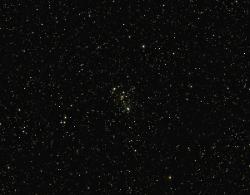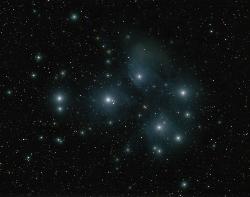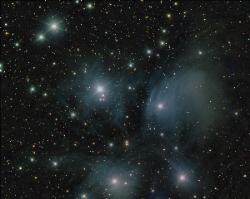OPEN STAR CLUSTERS
M-11 (NGC-6705): An exceptional galactic open cluster, located in the constellation of Scutum. This rich
cluster contains 400 stars brighter than 14th magnitude. Its visual size is approximately 12 minutes of arc,
which at its accepted distance of 5500 light years translates to a diameter of approximately 20 light years.
NOTE: This image was captured on 8/17/2012 and is an integration of fifteen 50 second exposures through
the 11-inch Celestron at f/2 using HyperStar and the SXVR-H694C color CCD imager. Captured and
combined using Maxim DL 5 Pro. Post-processed using Photoshop CS, levels, curves, Astro-tools and
Gradient X-terminator. Noise filtered andconverted to JPEG format using NoiseWare.
cluster contains 400 stars brighter than 14th magnitude. Its visual size is approximately 12 minutes of arc,
which at its accepted distance of 5500 light years translates to a diameter of approximately 20 light years.
NOTE: This image was captured on 8/17/2012 and is an integration of fifteen 50 second exposures through
the 11-inch Celestron at f/2 using HyperStar and the SXVR-H694C color CCD imager. Captured and
combined using Maxim DL 5 Pro. Post-processed using Photoshop CS, levels, curves, Astro-tools and
Gradient X-terminator. Noise filtered andconverted to JPEG format using NoiseWare.
(CLICK ON THUMBNAIL IMAGE FOR FULL-SIZE VIEW)
M-71 (NGC-6838): Located in the constellation Sagitta, approximately midway between the stars Delta and Gamma
Sagittae. It lies approximately 12,000 light years from Earth and is about 27 light years across. It was long thought to be
an extremely dense open cluster because it lacked the dense central compression found in globulars and lacked the
RR Lyrae type variable stars usually found in globulars. However, modern photometric research has detected a short
"horizontal branch" in the H-R diagram of stars in M-71, lending credibility to the fact that it MIGHT, in fact, be a loose
globular cluster.
NOTE: This image was captured on 8/11/2013, and is an integration of fifteen 60 second exposures through the
11-inch Celestron at f/2 using HyperStar and the Starlight Express SXVR-H694C 1-shot color imager. Captured and
combined using Maxim DL Pro v. 5.2. Post-processed using Photoshop CS, levels, curves, color balance & saturation,
and Gradient X-terminator and Astro-Tools.
Sagittae. It lies approximately 12,000 light years from Earth and is about 27 light years across. It was long thought to be
an extremely dense open cluster because it lacked the dense central compression found in globulars and lacked the
RR Lyrae type variable stars usually found in globulars. However, modern photometric research has detected a short
"horizontal branch" in the H-R diagram of stars in M-71, lending credibility to the fact that it MIGHT, in fact, be a loose
globular cluster.
NOTE: This image was captured on 8/11/2013, and is an integration of fifteen 60 second exposures through the
11-inch Celestron at f/2 using HyperStar and the Starlight Express SXVR-H694C 1-shot color imager. Captured and
combined using Maxim DL Pro v. 5.2. Post-processed using Photoshop CS, levels, curves, color balance & saturation,
and Gradient X-terminator and Astro-Tools.
NGC-7789: Located in the constellation of Cassiopeia, between the stars Rho and Sigma Cassiopeiae. A very rich
galactic open star cluster. It contains over 1,000 stars, and its visual size is approximately 20 minutes of arc, which
translates to an actual diameter of about 30 light years, given its accepted distance of 7,600 light years. Spectroscopic
study reveals this cluster to be much older than most open clusters. This cluster was discovered by Caroline Herschel in
1783.
NOTE: This image was captured on 9/16/2015 and is an integration of twenty-two 100 second exposures through the
C-11 at f/2 using the SXVR-H694C color imager. Total exposure time was 35 minutes. Guided, captured and combined
using Maxim DL Pro V5.2. Post-processed in Photoshop CS using levels, curves & Gradient X-terminator.
galactic open star cluster. It contains over 1,000 stars, and its visual size is approximately 20 minutes of arc, which
translates to an actual diameter of about 30 light years, given its accepted distance of 7,600 light years. Spectroscopic
study reveals this cluster to be much older than most open clusters. This cluster was discovered by Caroline Herschel in
1783.
NOTE: This image was captured on 9/16/2015 and is an integration of twenty-two 100 second exposures through the
C-11 at f/2 using the SXVR-H694C color imager. Total exposure time was 35 minutes. Guided, captured and combined
using Maxim DL Pro V5.2. Post-processed in Photoshop CS using levels, curves & Gradient X-terminator.
M-46 (NGC-2437): Located in the constellation of Puppis, about 14 degrees east of the brilliant star Sirius
(Alpha Canis Majoris). Discovered by Charles Messier in 1771. It contains about 200 stars ranging from
10th magnitude down to 14th magnitude and has a visual size of approximately 25 minutes of arc. The
brightest members are blue giants of spectral class AO, each having a true luminosity of over 100 times
that of the sun. This cluster lies at a distance of about 5400 light years from earth. A curious feature of this
cluster is the presence of the small planetary nebula NGC-2438, located approximately 7 arcminutes north
of the center of the cluster. It shows up in this CCD image just to the upper right of the center of the cluster.
It is believed that the nebula is not actually a member of M-46, as its radial velocity indicates that it is
probably 3300 light years from earth. This means that it is an "optical" or "line of sight" member of the
cluster.
NOTE: This image was captured on 3/14/2013 and is an integration of six 240-second exposures
through the C-11 at f/2 using HyperStar and the SXVR-H694C camera. Captured and combined using
Maxim DL 5. Post processed in Photoshop, levels, curves, gradient X-terminator and NoiseWare.
(Alpha Canis Majoris). Discovered by Charles Messier in 1771. It contains about 200 stars ranging from
10th magnitude down to 14th magnitude and has a visual size of approximately 25 minutes of arc. The
brightest members are blue giants of spectral class AO, each having a true luminosity of over 100 times
that of the sun. This cluster lies at a distance of about 5400 light years from earth. A curious feature of this
cluster is the presence of the small planetary nebula NGC-2438, located approximately 7 arcminutes north
of the center of the cluster. It shows up in this CCD image just to the upper right of the center of the cluster.
It is believed that the nebula is not actually a member of M-46, as its radial velocity indicates that it is
probably 3300 light years from earth. This means that it is an "optical" or "line of sight" member of the
cluster.
NOTE: This image was captured on 3/14/2013 and is an integration of six 240-second exposures
through the C-11 at f/2 using HyperStar and the SXVR-H694C camera. Captured and combined using
Maxim DL 5. Post processed in Photoshop, levels, curves, gradient X-terminator and NoiseWare.
M-36 (NGC-1960): Located in the constellation of Auriga. A bright open star cluster con-
taining about 60 stars ranging in magnitudes from 9 to 14. Most of the brighter members are all B-type
blue-white stars. This is one of the younger open clusters in the milky way. It lies at a distance of
approximately 4100 light years from earth. At this distance, the angular size of the cluster, 12 arcminutes,
translates to an actual diameter of about 14 light years.
NOTE: This image was captured on the evening of October 30, 2008, and is an integration of twenty-five
25 second exposures through an 80mm APO refractor at f/3.75. The image were captured and combined
usingMaxim DL Essentials, with additional post-processing using Photoshop CS and Astro-Tools. Noise
filtered and converted to JPEG format using NoiseWare.
taining about 60 stars ranging in magnitudes from 9 to 14. Most of the brighter members are all B-type
blue-white stars. This is one of the younger open clusters in the milky way. It lies at a distance of
approximately 4100 light years from earth. At this distance, the angular size of the cluster, 12 arcminutes,
translates to an actual diameter of about 14 light years.
NOTE: This image was captured on the evening of October 30, 2008, and is an integration of twenty-five
25 second exposures through an 80mm APO refractor at f/3.75. The image were captured and combined
usingMaxim DL Essentials, with additional post-processing using Photoshop CS and Astro-Tools. Noise
filtered and converted to JPEG format using NoiseWare.
M-37 (NGC-2099):_A superbly rich open cluster in Auriga, considered one of the finest of the three Messier
open clusters in that constellation. M-37 contains over 150 stars ranging in magnitude from 9 to 12.5. The
stellar population of this cluster is very different from M-36, and suggests that the cluster is much older. It
also contains several red giants, which stand out like rubys in a field of white diamonds. M-37 lies at a
distance of 4700 light years and is approximately 25 light years in diameter.
NOTE: This image was captured on the evening of December 27,2013, and is an integration of four 240
second exposures through the 11-inch Celestron at f/2 using the SXVR-H694C imager. Captured and
combined using Maxim DL 5 Pro. Post-processed using Photoshop CS levels,curves & Gradient X-terminstor.
open clusters in that constellation. M-37 contains over 150 stars ranging in magnitude from 9 to 12.5. The
stellar population of this cluster is very different from M-36, and suggests that the cluster is much older. It
also contains several red giants, which stand out like rubys in a field of white diamonds. M-37 lies at a
distance of 4700 light years and is approximately 25 light years in diameter.
NOTE: This image was captured on the evening of December 27,2013, and is an integration of four 240
second exposures through the 11-inch Celestron at f/2 using the SXVR-H694C imager. Captured and
combined using Maxim DL 5 Pro. Post-processed using Photoshop CS levels,curves & Gradient X-terminstor.
M-38 (NGC- 1912) and NGC-1907 (to the right - west): M-38 is a large bright open cluster in Auriga,
located about 2.3 degrees NW of M-36. It is a scattered group of irregular form,oriented NW to SE. It is
approximately 20 arcminutes in diameter, which at its calculated distance of 4200 light years corresponds
to an actual diameter of about 25 light years. The smaller, more compact open cluster NGC-1907 lies just
at the west edge of the field of this image.
NOTE: This image captured on October 30, 2008. It is an integration of twenty-five 25 second exposures
through the 80mm APO refractor at f/3.75. Combined and processed inMaxim DL Essentials, with
post-processing using Photoshop CS and Noiseware.
located about 2.3 degrees NW of M-36. It is a scattered group of irregular form,oriented NW to SE. It is
approximately 20 arcminutes in diameter, which at its calculated distance of 4200 light years corresponds
to an actual diameter of about 25 light years. The smaller, more compact open cluster NGC-1907 lies just
at the west edge of the field of this image.
NOTE: This image captured on October 30, 2008. It is an integration of twenty-five 25 second exposures
through the 80mm APO refractor at f/3.75. Combined and processed inMaxim DL Essentials, with
post-processing using Photoshop CS and Noiseware.
M-35 (NGC-2168) and NGC-2158: M-35 is a beautiful open star cluster in the constellation of Gemini.
First cataloged by de Cheseaux in 1745 and cataloged by Messier in 1764 as the 35th object on his list.
Visually, M-35 is about 30 arcminutes in diameter when viewed through modest sized telescopes. It lies at
a distance of approximately 2800 light years from earth. It containsabout 120 stars ranging from B3 to G0
in the main sequence. Most of the members are 8th to10th magnitude. About 1/2 degree SW (to the right
in this image) from M-35 is the very rich and distant cluster NGC-2158. This cluster is actually the same
physical size as M-35, but lies over 8 times further away than M-35. Modern measurements place its
distance at over 18,000 light years. Through 8 to 12 inch telescopes, NGC-2158 appears as a very rich
compressed cluster,somewhat triangular in shape, with a misty, granular texture.
NOTE: The LH image was captured on 3/14/2013 and is an integration of five 240 second exposures
through the C-11 at f/2 using HyperStar and the Starlight Express SXVR-H694C color imager. Captured
and combined using Maxim DL 5 Pro v. 5.2. Post processed in Photoshop CS, levels, curves, Astro-tools,
Gradient X-terminator. The RH image was captured on 1/23/2018 and is an integration of five 6 minute
exposures using the new ZWO ASI071 wide field imager. Guided, captured & combined using Maxim DL5.
Post processed using PhotoShop CS2, levels, curves, Gradient XTerminator and StarShrink.
First cataloged by de Cheseaux in 1745 and cataloged by Messier in 1764 as the 35th object on his list.
Visually, M-35 is about 30 arcminutes in diameter when viewed through modest sized telescopes. It lies at
a distance of approximately 2800 light years from earth. It containsabout 120 stars ranging from B3 to G0
in the main sequence. Most of the members are 8th to10th magnitude. About 1/2 degree SW (to the right
in this image) from M-35 is the very rich and distant cluster NGC-2158. This cluster is actually the same
physical size as M-35, but lies over 8 times further away than M-35. Modern measurements place its
distance at over 18,000 light years. Through 8 to 12 inch telescopes, NGC-2158 appears as a very rich
compressed cluster,somewhat triangular in shape, with a misty, granular texture.
NOTE: The LH image was captured on 3/14/2013 and is an integration of five 240 second exposures
through the C-11 at f/2 using HyperStar and the Starlight Express SXVR-H694C color imager. Captured
and combined using Maxim DL 5 Pro v. 5.2. Post processed in Photoshop CS, levels, curves, Astro-tools,
Gradient X-terminator. The RH image was captured on 1/23/2018 and is an integration of five 6 minute
exposures using the new ZWO ASI071 wide field imager. Guided, captured & combined using Maxim DL5.
Post processed using PhotoShop CS2, levels, curves, Gradient XTerminator and StarShrink.
M-52 (NGC-7654): The brightest open cluster in the constellation Cassiopiea, located on the western edge of the
constellation. M-52 is a large, rich, fairly compressed cluster, which contains almost 120 stars from 9th to 12th magnitude.
It lies approximately 3000 light years from earth and is about 15 light years in diameter. The two brightest members of the
cluster are yellow giants of spectral class F9 and shine at 7.8 and 8.2 magnitude.
NOTE: This image was captured on the evening of July 29,2014, and is an integration of ten 360-second exposures
through the 11-inch Celestron at f/2, using the HyperStar system and the SXVR-H694C imager. Captured in Maxim DL
Pro v. 5.2, post-processed in Photoshop CS, levels, curves & color balance, Astro-Tools and Gradient XTerminator.
constellation. M-52 is a large, rich, fairly compressed cluster, which contains almost 120 stars from 9th to 12th magnitude.
It lies approximately 3000 light years from earth and is about 15 light years in diameter. The two brightest members of the
cluster are yellow giants of spectral class F9 and shine at 7.8 and 8.2 magnitude.
NOTE: This image was captured on the evening of July 29,2014, and is an integration of ten 360-second exposures
through the 11-inch Celestron at f/2, using the HyperStar system and the SXVR-H694C imager. Captured in Maxim DL
Pro v. 5.2, post-processed in Photoshop CS, levels, curves & color balance, Astro-Tools and Gradient XTerminator.
M-21 (NGC-6531): An open star cluster located in western Sagittarius, just north of the Trifid Nebula (M-20).
It is a relatively young cluster, being less than 5 million years old. It consists of
57 stars, many of which are blue-white giants. It lies at a distance of approximatley 2500 to 4000
light years from Earth.
NOTE: This image captured on the evening of July 14, 2012 and is an integration of ten 90-second
exposures through the Celestron 11-inch at f/2, using the HyperStar 3 imaging system and the
Starlight Express SXVR-H694C 1-shot color CCD camera. Captured and combined using Maxim DL
5 Pro. Post-processed using Photoshop CS, levels, curves, star reduction and Gradient Exterminator.
It is a relatively young cluster, being less than 5 million years old. It consists of
57 stars, many of which are blue-white giants. It lies at a distance of approximatley 2500 to 4000
light years from Earth.
NOTE: This image captured on the evening of July 14, 2012 and is an integration of ten 90-second
exposures through the Celestron 11-inch at f/2, using the HyperStar 3 imaging system and the
Starlight Express SXVR-H694C 1-shot color CCD camera. Captured and combined using Maxim DL
5 Pro. Post-processed using Photoshop CS, levels, curves, star reduction and Gradient Exterminator.
NGC-6791: A very rich open star cluster located in the constellation of Lyra, the Lyre. This cluster is thought to be one
of the very oldest open clusters in our galaxy. Based on the heavy metal content of its member stars, which contain
over twice the amount of iron as our sun, NGC-6791 is estimated to be almost 8 billion years old. Because of this as
well as its density, it is one of the most studied open clusters in our galaxy.
NOTE: This image was captured on August 10th, 2012 and is an integration of fifteen 60 second exposures through the
11-inch Celestron at f/2 using the HyperStar 3 imaging system and the Starlight Express SXVR-H694C 6 megapixel
camera. Captured and combined in Maxim DL 5 Pro. Post-processed using Photoshop, levels & curves, AstroTools,
and NoiseWare.
of the very oldest open clusters in our galaxy. Based on the heavy metal content of its member stars, which contain
over twice the amount of iron as our sun, NGC-6791 is estimated to be almost 8 billion years old. Because of this as
well as its density, it is one of the most studied open clusters in our galaxy.
NOTE: This image was captured on August 10th, 2012 and is an integration of fifteen 60 second exposures through the
11-inch Celestron at f/2 using the HyperStar 3 imaging system and the Starlight Express SXVR-H694C 6 megapixel
camera. Captured and combined in Maxim DL 5 Pro. Post-processed using Photoshop, levels & curves, AstroTools,
and NoiseWare.
M-6 (NGC-6405): One of the brightest galactic star clusters, and one of the nicest to observe
using a small telescope. Located 5 degrees north of the "tail" of Scorpius the Scorpion. It is an
oblong cluster of approximately 50 stars ranging from 6th down to 10.5 magnitude. Due to its shape it is
sometimes called "The Butterfly Cluster". It lies approximately 1500 light years from Earth:
NOTE: This image was captured on the evening of July 27, 2019 and is an integration of five 6 minute
exposures through the 11-inch Celestron at f/2 using HyperStar and the SXVR-H649C color CCD imager.
Guided, captured and combined using Maxim DL 5 Pro. Post processed using Photoshop CS, levels,
curves, Carboni's Astro Tools, Gradient Xterminator and NoiseWare.
.
using a small telescope. Located 5 degrees north of the "tail" of Scorpius the Scorpion. It is an
oblong cluster of approximately 50 stars ranging from 6th down to 10.5 magnitude. Due to its shape it is
sometimes called "The Butterfly Cluster". It lies approximately 1500 light years from Earth:
NOTE: This image was captured on the evening of July 27, 2019 and is an integration of five 6 minute
exposures through the 11-inch Celestron at f/2 using HyperStar and the SXVR-H649C color CCD imager.
Guided, captured and combined using Maxim DL 5 Pro. Post processed using Photoshop CS, levels,
curves, Carboni's Astro Tools, Gradient Xterminator and NoiseWare.
.
M-45, The Pleiades Cluster: Located in Taurus, The Bull, this is one of the nearest open
clusters, being only 400 light years from Earth. It is a very young cluster, only 100 million years
old, and is dominated by hot, extremely luminous blue-white stars. The cluster is enveloped in
a cloud of interstellar dust which is not related to the formation of the cluster, but which the
main stars are currently passing through. The most famous part of the dust cloud is the
reflection nebula surrounding the star Merope, seen at the right center of the image.
NOTE: The left hand image was captured on November 8, 2013, and is a composite of eight 6-minute
sub-exposures through the 11-inch Celestron at f/2 using HyperStar and the Starlight Express
SXVR-H694C CCD Camera. The images were captured using Maxim DL 5 Pro. Post-processed using
Photoshop CS, levels, curves, color balance & saturation, and Gradient X-Terminator.
The right hand image was captured on December 18, 2017, and is a composite of ten 360
second exposures through the wider field ZWO ASI-071-MC one-shot color camera. Guided,
captured and combined using Maxim DL5. Processed using PhotoShop CS2, levels, curves,
saturation, Gradient XTerminator and StarShrink.
clusters, being only 400 light years from Earth. It is a very young cluster, only 100 million years
old, and is dominated by hot, extremely luminous blue-white stars. The cluster is enveloped in
a cloud of interstellar dust which is not related to the formation of the cluster, but which the
main stars are currently passing through. The most famous part of the dust cloud is the
reflection nebula surrounding the star Merope, seen at the right center of the image.
NOTE: The left hand image was captured on November 8, 2013, and is a composite of eight 6-minute
sub-exposures through the 11-inch Celestron at f/2 using HyperStar and the Starlight Express
SXVR-H694C CCD Camera. The images were captured using Maxim DL 5 Pro. Post-processed using
Photoshop CS, levels, curves, color balance & saturation, and Gradient X-Terminator.
The right hand image was captured on December 18, 2017, and is a composite of ten 360
second exposures through the wider field ZWO ASI-071-MC one-shot color camera. Guided,
captured and combined using Maxim DL5. Processed using PhotoShop CS2, levels, curves,
saturation, Gradient XTerminator and StarShrink.
M-93 (NGC-2447) A bright open cluster located in the constellation of Puppis. Discovered by Charles Messier in 1782.
It is located approximately 3600 Light Years from Earth and is approximately 12 light years in extent. It is a relatively young
cluster, about 100 million years old. The brightest members of the cluster are blue giants of the type B9.
NOTE: This image was taken on December 28th, 2013, and is an integration of nine 4-minute exposures through the
11-inch Celestron at f/2 using the HyperStar system and the Starlight Express SXVR-H694C color CCD imager. Captured
and combined using Maxim DL 5 Pro. Post-processed using Photoshop CS, levels & curves, color saturation, and Gradient
X-terminator.
It is located approximately 3600 Light Years from Earth and is approximately 12 light years in extent. It is a relatively young
cluster, about 100 million years old. The brightest members of the cluster are blue giants of the type B9.
NOTE: This image was taken on December 28th, 2013, and is an integration of nine 4-minute exposures through the
11-inch Celestron at f/2 using the HyperStar system and the Starlight Express SXVR-H694C color CCD imager. Captured
and combined using Maxim DL 5 Pro. Post-processed using Photoshop CS, levels & curves, color saturation, and Gradient
X-terminator.
M-50 (NGC-2323): A large open star cluster in the constellation of Monoceros, close to the border with Canis
Major, about 4 degrees NE of the 4th magnitude star Theta Canis Majoris. It is fairly large, over 16 arc minutes
in diameter, and fairly rich. It contains over 100 stars. The brightest are mainly blue-white, although there are
several bright orange and yellow stars which give it visual appeal. It lies approximately 3200 light years from
Earth, and has an estimated age of 78 million years.
NOTE: This image was captured on March 20th, 2015, and is an integration of six 120-second exposures
through the 11-inch Celestron at f/2 using HyperStar and the Starlight Express SXVR-H694C CCD imager.
The images were captured and combined using Maxim DL Pro. Post processed using Photoshop CS2,
Gradient X-Terminator and Carboni's Astro-Tools. Guiding was done using Maxim DL Pro v. 5.2.
Major, about 4 degrees NE of the 4th magnitude star Theta Canis Majoris. It is fairly large, over 16 arc minutes
in diameter, and fairly rich. It contains over 100 stars. The brightest are mainly blue-white, although there are
several bright orange and yellow stars which give it visual appeal. It lies approximately 3200 light years from
Earth, and has an estimated age of 78 million years.
NOTE: This image was captured on March 20th, 2015, and is an integration of six 120-second exposures
through the 11-inch Celestron at f/2 using HyperStar and the Starlight Express SXVR-H694C CCD imager.
The images were captured and combined using Maxim DL Pro. Post processed using Photoshop CS2,
Gradient X-Terminator and Carboni's Astro-Tools. Guiding was done using Maxim DL Pro v. 5.2.
M-67 (NGC-2682): An open cluster in the constellation Cancer the crab. Discovered by Kohler in
1779. It lies approximately 2900 light years from Earth.
NOTE: This image captured on March 20, 2015 and is an integration of five 120-second exposures
through the C-11 at f/2 using HyperStar. Captured and combined using Maxim DL 5 Pro. Post
processed in Photoshop CS2, levels & curves, Astro Tools and Gradient X-terminator.
1779. It lies approximately 2900 light years from Earth.
NOTE: This image captured on March 20, 2015 and is an integration of five 120-second exposures
through the C-11 at f/2 using HyperStar. Captured and combined using Maxim DL 5 Pro. Post
processed in Photoshop CS2, levels & curves, Astro Tools and Gradient X-terminator.
NGC-6939: An open cluster located in the constellation of Cepheus, almost on the border with Cygnus. It lies just 1/2
degree NW of the spiral galaxy NGC-6946. This is a galactic open cluster which lies at a distance of 5800 light years from
earth. Visually, it is 7.8 magnitude, is about 8 arc minutes in diameter, and is a pleasing sight in moderate sized telescopes.
NOTE: This image was captured on the evening of August 12, 2015 and is a 1 hour and 40 minute exposure through the
Celestron 11 @ f/2 using HyperStar and the SXVR-H694C color imager. Guided, captured and combined using Maxim DL
5 Pro. Post-processed in PhotoShop CS, levels, curves, Gradient X-Terminator and NoiseWare.
degree NW of the spiral galaxy NGC-6946. This is a galactic open cluster which lies at a distance of 5800 light years from
earth. Visually, it is 7.8 magnitude, is about 8 arc minutes in diameter, and is a pleasing sight in moderate sized telescopes.
NOTE: This image was captured on the evening of August 12, 2015 and is a 1 hour and 40 minute exposure through the
Celestron 11 @ f/2 using HyperStar and the SXVR-H694C color imager. Guided, captured and combined using Maxim DL
5 Pro. Post-processed in PhotoShop CS, levels, curves, Gradient X-Terminator and NoiseWare.
M-103 (NGC-581): A galactic open cluster in the constellation Cassiopiea, located 1 degree east
of Delta Cassiopieae, on a line between Delta and Epsilon Cassiopieae. It is about 7 arc minutes in
diameter, which at its distance of 10,000 light years corresponds to an actual diameter of 17.5 light
years. The cluster is dominated by the 7.5 magnitude multiple star Struve 131, which is not an
actual member of the cluster and lies much closer to us but on the same line-of sight. The cluster
itself makes a pretty sight in amateur telescopes, and contains over 30 stars in a somewhat wedge
shaped group.
NOTE: This image captured on the evening of 9/16/2015 and is an integration of ten 100 second
exposures for a total exposure time of 15-1/2 minutes. Guided, captured and combined using
Maxim DL Pro V5.2. Post-processed in PhotoShop CS, levels, curves & gradient X-terminator.
of Delta Cassiopieae, on a line between Delta and Epsilon Cassiopieae. It is about 7 arc minutes in
diameter, which at its distance of 10,000 light years corresponds to an actual diameter of 17.5 light
years. The cluster is dominated by the 7.5 magnitude multiple star Struve 131, which is not an
actual member of the cluster and lies much closer to us but on the same line-of sight. The cluster
itself makes a pretty sight in amateur telescopes, and contains over 30 stars in a somewhat wedge
shaped group.
NOTE: This image captured on the evening of 9/16/2015 and is an integration of ten 100 second
exposures for a total exposure time of 15-1/2 minutes. Guided, captured and combined using
Maxim DL Pro V5.2. Post-processed in PhotoShop CS, levels, curves & gradient X-terminator.
THE "DOUBLE CLUSTER" (NGC-884 AND NGC-869): Two large bright open star clusters in the constellation of
Perseus. This pair of clusters is visible to the unaided eye as a faint misty patch east and slightly south of the familiar
"W" shape of the constellation Cassiopeia. NGC-884 to the east (right) is distinguishable from its neighbor by its more
open structure and the presence of a number of bright red supergiant stars.
NOTE: This image taken on the evening of December 18, 2017 is an integration of six 360-second exposures through
the ZWO-ASI 071-MC one-shot color camera. Guided, captured and combined using Maxim DL5. Post processed using
PhotoShop CS2, levels, curves, saturation, Gradient XTerminator and StarShrink.
Perseus. This pair of clusters is visible to the unaided eye as a faint misty patch east and slightly south of the familiar
"W" shape of the constellation Cassiopeia. NGC-884 to the east (right) is distinguishable from its neighbor by its more
open structure and the presence of a number of bright red supergiant stars.
NOTE: This image taken on the evening of December 18, 2017 is an integration of six 360-second exposures through
the ZWO-ASI 071-MC one-shot color camera. Guided, captured and combined using Maxim DL5. Post processed using
PhotoShop CS2, levels, curves, saturation, Gradient XTerminator and StarShrink.
CLUSTERS IN CASSIOPEIA: This fall/winter constellation is well known for its many and varied open star clusters. This
image of an area just NW of Beta Cassiopieae captures five of them in a diagonal line from the lower RH corner of the
image to the upper LH corner. Just to the right (west) of the bright star at the bottom center of the image is Berkeley 58.
Just north of it, left of the yellowish star is NGC-7790. On to the NE, near the center of the image is NGC-7788 and NE of
it, between two bright stars is Harvard 21. And at the upper LH corner, partially cut off is King 12. These five clusters lie
well within the boundaries of the Milky Way, as evidenced by the starry field.
NOTE: This image obtained on October 5, 2019. Guided, captured and combined using Maxim DL. Post processed using
PhotoShop CS2, levels, curves, gradient XTerminator, StarShrink, and Noiseware.
image of an area just NW of Beta Cassiopieae captures five of them in a diagonal line from the lower RH corner of the
image to the upper LH corner. Just to the right (west) of the bright star at the bottom center of the image is Berkeley 58.
Just north of it, left of the yellowish star is NGC-7790. On to the NE, near the center of the image is NGC-7788 and NE of
it, between two bright stars is Harvard 21. And at the upper LH corner, partially cut off is King 12. These five clusters lie
well within the boundaries of the Milky Way, as evidenced by the starry field.
NOTE: This image obtained on October 5, 2019. Guided, captured and combined using Maxim DL. Post processed using
PhotoShop CS2, levels, curves, gradient XTerminator, StarShrink, and Noiseware.
NGC-457: Sometimes called the "Owl" nebula. The brightest star, located at the southeast edge of the
cluster, is Phi Cassiopeiae, a 5th magnitude star. In amateur telescopes NGC-457 is a marvelous sight
due to its bright members and dense concentration. It is somewhat kite-shaped. It lies about 7,900 light
years from Earth.
NOTE: This image is an integration of six 6-minute exposures through the C-11 at f/2. Guided, captured
and combined using Maxim DL, Post-processed using PhotoShop CS2. Image obtained on 10/5/2019.
cluster, is Phi Cassiopeiae, a 5th magnitude star. In amateur telescopes NGC-457 is a marvelous sight
due to its bright members and dense concentration. It is somewhat kite-shaped. It lies about 7,900 light
years from Earth.
NOTE: This image is an integration of six 6-minute exposures through the C-11 at f/2. Guided, captured
and combined using Maxim DL, Post-processed using PhotoShop CS2. Image obtained on 10/5/2019.
M-34 (NGC-1039): A bright open star cluster located approximately 5 degrees WNW from Algol (Beta
Perseii) the famous variable star. Discovered by Charles Messier in August 1764 and assigned number
34 in his famous catalog. This is a beautiful cluster, best observed at low powers. It is similar in general
appearance and brightness to the cluster M-36 in Auriga. It is approximately 20 arc minutes in apparent
size and lies about 1500 light years from Earth.
NOTE: This image was obtained on October 5, 2019, and is an integration of four 6 minute exposures
taken through the C-11 at f/2 using the HyperStar imaging system and the SXVR-H694C color imager.
Guided, captured and combined using Maxim DL 5.2 Pro. Post-processed in PhotoShop CS2, using
levels, curves, Gradient XTerminator and StarShrink, and NoiseWare.
Perseii) the famous variable star. Discovered by Charles Messier in August 1764 and assigned number
34 in his famous catalog. This is a beautiful cluster, best observed at low powers. It is similar in general
appearance and brightness to the cluster M-36 in Auriga. It is approximately 20 arc minutes in apparent
size and lies about 1500 light years from Earth.
NOTE: This image was obtained on October 5, 2019, and is an integration of four 6 minute exposures
taken through the C-11 at f/2 using the HyperStar imaging system and the SXVR-H694C color imager.
Guided, captured and combined using Maxim DL 5.2 Pro. Post-processed in PhotoShop CS2, using
levels, curves, Gradient XTerminator and StarShrink, and NoiseWare.
